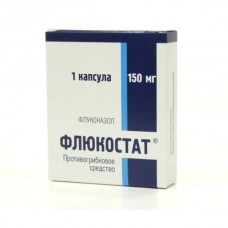Expiration date: 03/2025
The composition and form of issue:
1 capsule contains fluconazole 0.05 or 0.15 g in a contour package 7 and 1 units respectively.
Feature:
Opaque capsule light pink/pinkish-brown color (0.05 g) and white color (0.15 g).
Pharmacological action:
Specifically inhibits the biosynthesis of ergosterol, part of the cell membrane of the fungus.
Pharmacokinetics:
Well absorbed from the gastrointestinal tract, food intake does not affect absorption. Bioavailability 90%, tying with the plasma protein — 11-12%. Cmax is achieved in 1-2 hours Penetrates through the BBB, is widely distributed in tissues and organs. The concentration in breast milk, joint fluid, saliva, sputum, vaginal secretions and peritoneal fluid is equal to that in plasma. T1/2 is 30 h. write mainly kidneys in an unmodified form (80%) and as metabolites (11%).
Description pharmacological action:
Effective in systemic infections caused by Candida and Cryptococcus neoformans, as well as in respect of Hystoplasma capsulatum, Blastomyces dermatitidis, Coccidioides immitis, fungi of the genus Microsporum and Trichophyton.
Indications:
Systemic candidiasis (candidemia, disseminated candidiasis), mucosal candidiasis and skin and systemic lesions caused by the fungus Cryptococcus (meningitis, pneumonia, etc.), including in patients with various forms of immunosuppression, fungal infection of the skin, onychomycosis, pityriasis versicolor, endemic mycoses (coccidioidomycosis, paracoccidioidomycosis, sporotrichosis, histoplasmosis, etc.).
Contraindications:
Hypersensitivity, pregnancy, breast-feeding.
Application of pregnancy and breast-feeding:
Contraindicated.
Side effects:
Allergic reactions (skin rash, Stevens-Johnson syndrome, anaphylactic shock), toxic epidermal necrolysis, polymorphic erythema, nausea, vomiting, pain in the lower abdomen, bloating, diarrhea, headache, dizziness.
Drug interactions:
While the use of oral anticoagulants of the cumarin type — prolongation of prothrombin time with oral hypoglycemic agents (glibenclamide, glipizide, tolbutamide) increase the risk of hypoglycemia (increasing their T1/2). Rifampicin shortens T1/2 fluconazole.
Method of application and dose:
Inside, daily, 1 time per day. Treatment is continued until the appearance of clinical and hematological remission (with the exception of acute vaginal candidiasis, is usually cured with a single dose of 0.15 g).
Adults: candidemia, disseminated candidiasis and other invasive candidiasis: initial dose of 0.4 g/day, in the following days, 0.2–0.4 g/day with cryptococcal meningitis. cryptococcal lesions in 1-day — 0,4 g, then 0.2–0.4 g/day one (course duration depends on clinical and mycological response, with cryptococcal meningitis — at least 6-8 weeks). If oropharyngeal candidiasis: 0.05–0.1 g/day for 7-14 days in atrophic oral candidiasis: 0.05 g/day for 14 days (at the same time by local antiseptic treatment). Other candidiasis of the mucous membranes: on 0.05–0.1 g/day for 14-30 days. Skin mycosis, including groin, foot and candidiasis of the skin: 0.15 g of 1 time per week or 0.05 g/day for 2-4 weeks (for athlete's foot — 6 weeks). In the treatment of tinea versicolor: 0.05 g/day for 2-4 weeks, in onychomycosis: 0.15 g of 1 times a week (the treatment continues until the full replacement of the infected nail). Endemic mycosis: 0.2–0.4 g/day for 1-2 years. For acute vaginal candidosis and candidal balantine: 0.15 g once, chronic, often recurrent vaginal candidiasis: 0.15 g monthly for 4-12 months.
With continuous therapy, treatment should begin with high doses of 0.05–0.4 g, then the frequency of administration and dose depends on creatinine clearance: Cl with more than 50 ml/min, the normal daily dose every 24 h 11-50 ml/min, usual daily dose every 48 hours or half the daily dose every 24 hours.
Children with candidiasis of the mucous membranes: 1st day — 0,006 g/kg/day, followed by 0.003 g/kg/day, with systemic candidiasis or cryptococcosis — dose 0,006–0,012 g/kg/day depending on the severity of the disease. At violation of functions of kidneys the daily dose for children is reduced in accordance with the guidance for adults.
Overdose:
Treatment: gastric lavage, forced diuresis, hemodialysis, symptomatic therapy.
Precautions:
Be used with caution in patients with impaired renal function. Discontinue treatment when liver dysfunction and worsening of skin symptoms (possible Stevens-Johnson syndrome, toxic epidermal necrolysis).




